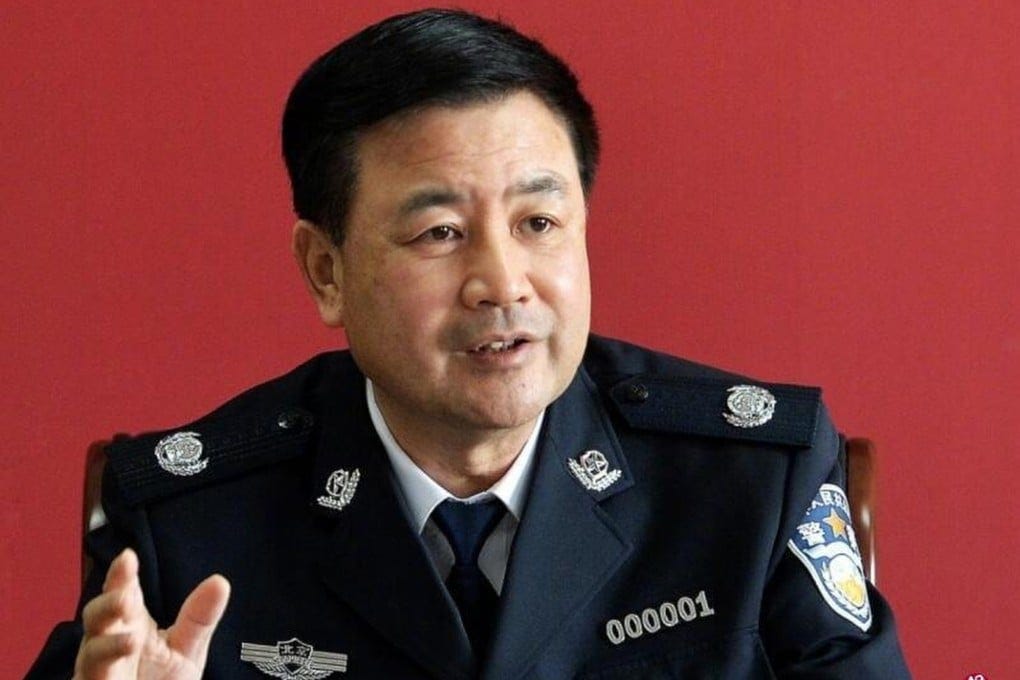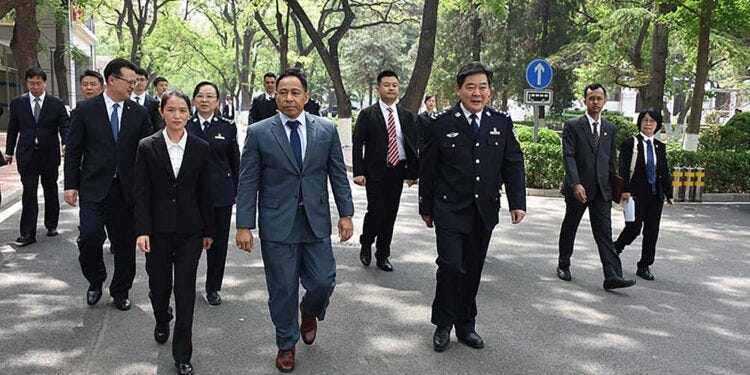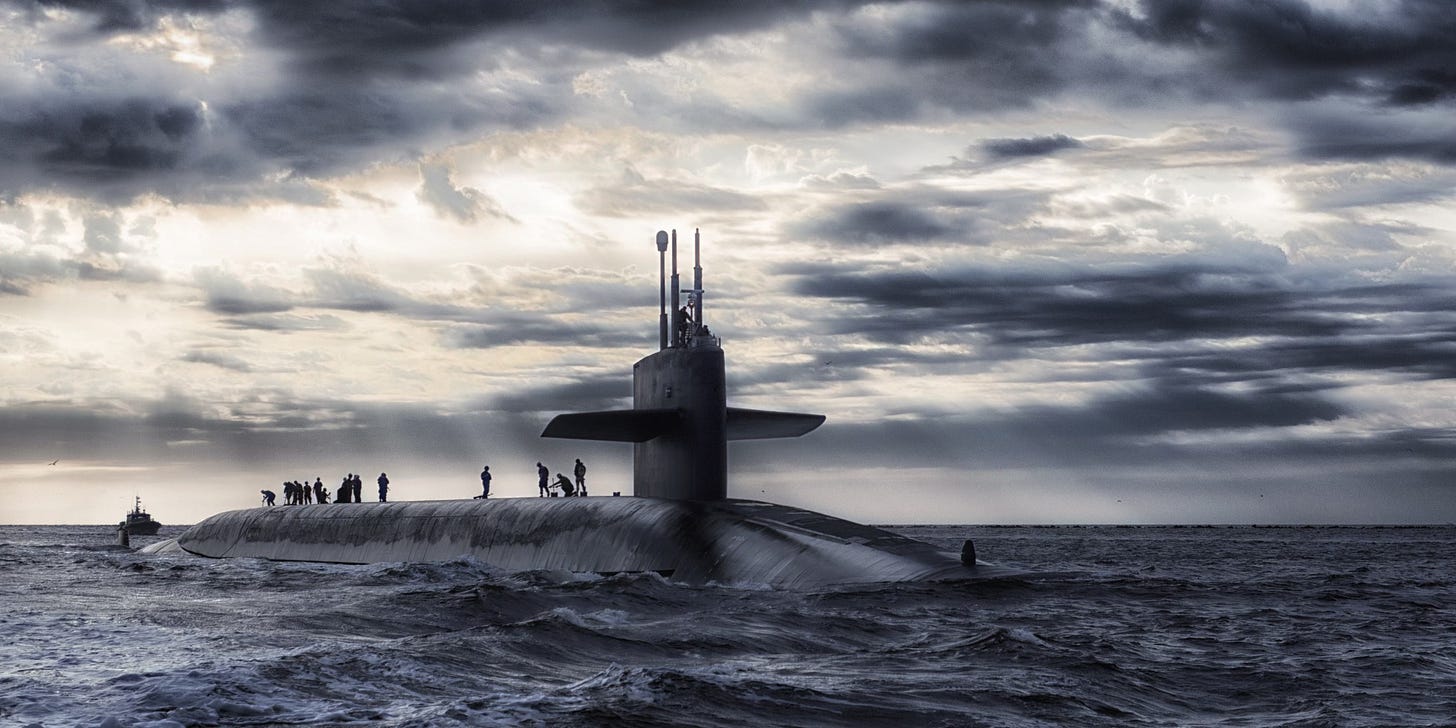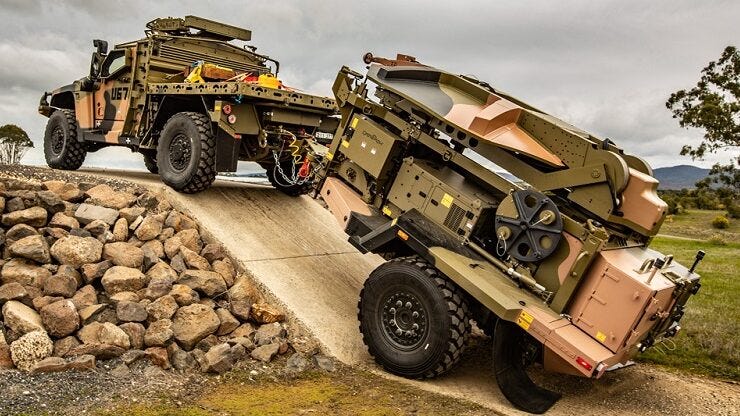Deputy Pacific Sheriff
Featured contributor Geoff Raby on Australia’s ‘”deputy Sheriff” role, which has been on full display again in our foreign policy. Also, PM's extraordinary gaff at the Pacific Islands Leaders Forum
The deputy sheriff rides again
By Geoff Raby
In recent days, Australia’s ‘”deputy Sheriff” role has been on full display again in our foreign policy.
The prime minister’s extraordinary gaff at the Pacific Islands Leaders Forum, when caught out joshing along with US Deputy Secretary of State, Kurt Campbell, would have been noted not just among Pacific Island leaders, who would be entitled to feel belittled by Australia, but also across the region.
It was not just the prime minister’s gushing in the presences of great and powerful friends, but the extraordinary arrogance of Campbell telling Anthony Albanese that he had “cleared the lane” for Australia so we should now “take it”.
The sheriff had spoken, and Australia’s leader was seeking brownie points, and “halvies”, for having delivered. It was interesting that Campbell said he was acting at the request of Australia’s ambassador to Washington, rather than our foreign minister. This was a rare and telling insight into whom Campbell believes makes foreign policy for Australia’s most important relationship.
As if the Tonga Incident were not enough, Foreign Minister Penny Wong felt it necessary to reassure the US in her keynote speech at the AFR’s Asia Summit last week that alliance maintenance was Australia’s highest priority when approaching the Asian region. As if it were ever in any doubt.
It is well known that DFAT doesn’t like to re-type the page of its talking points as, for example, can be seen from the minister still saying the government is “stabilising” the relationship with China, even though we have had reciprocal head of government visits, and frequent ministerial exchanges and other meetings. It is well past time to move on.
Endlessly reasserting the primacy of the US alliance for Australia’s foreign and security policy seems hardly necessary when this government has so fulsomely embraced the abrogation of Australia’s independence with AUKUS and offering Australia up for forward basing of US strategic weapons.
Who is the audience and what is the purpose of this incantation? Beijing certainly knows Australia is glued to the hip of the US. It is likely regional countries have also worked this out. All our actions speak much louder than the foreign minister’s words in this respect. And our ambassador in Washington would have left no one in any doubt that we relish our role as deputy sherif.
Describing Australia as the US’ “deputy sheriff” in the region was attributed to John Howard during an interview early in his term as prime minister. The then Labor Opposition pounced on this; Howard was ridiculed across the country.
It is disputed whether Howard actually said those words. In any event, some earlier positions he took made them unnecessary. Howard, for example, was the only world leader to back publicly Bill Clinton’s sending two aircraft carrier groups through the Taiwan Straits following an unprovoked firing of live missile salvos by China at Taiwan.
And soon after the “deputy sherif” furore, Howard marched Australian troops off to Iraq and Afghanistan in support of deeply flawed US hegemonic objectives.
Wong’s AFR speech also sought to emphasise the importance of building a network of bilateral and minilateral relations across the region as a bulwark against an inexorably rising China. She recounted at some length the history of Australia’s post-colonial relations with non-aligned Indonesia. But as Greg Earl said of her speech in a recent Lowy report, “ostentatiously praising Indonesian non-alignment while elevating the US alliance above partnering with the region” would raise eyebrows in Jakarta.
Prioritising the US is a reflex in Australian foreign policy which cuts across good intentions and real efforts to build closer relations with the region. When, for example, elevated rotations of US marines were announced in 2011 in Darwin by Prime Minister Julia Gillard and President Barak Obama, Indonesia had clearly not been given a heads up as would be normal diplomatic practice in a relationship of mutual trust, especially with one’s closest neighbour.
When asked by an intrepid ABC journalist what Indonesia thought of the announcement, the ANU-educated Indonesian Foreign Minister, Marty Natalegawa, angrily stared down the barrel of the camera and said “he was not aware Australia saw Indonesia as an imminent military threat”.
Prioritising the US has also constrained Australia’s response to Gaza in ways that sets us apart from Indonesia, Malaysia and Brunei. Australia had an opportunity to join with five European states recently to recognise the state of Palestine, but declined to do so.
Similar indifference to regional sensitivities on the Middle East saw former Prime Minister Scott Morrison offend Australia’s Islamic neighbours when, during the Wentworth byelection several years ago, he announced without any forewarning that Australia would follow the US and move its embassy from Tel Aviv to Jerusalem.
While AUKUS has received a mixed reaction in the region, the symbolism and messaging it conveys are clear: priority for the US alliance over any other relations with the region. With the government’s commitment to AUKUS, it is hardly necessary, therefore, for the foreign minister to keep emphasising US primacy in our foreign policy settings. As James Curran observed in these pages, the Australian Government speaks with a “forked tongue” on regional engagement.
For Australia to have the thick, resilient, sinews of relationships across ASEAN to which the foreign minister seems genuinely to aspire, the government’s mindset will need to move beyond the deputy sheriff role. We have done that in the past on occasions, and Wong’s speech highlighted some important examples from early post-colonial Indonesia.
Disappointingly, she chose to ignore one of the most important occasions when Australia stood with Indonesia to resist US pressure. This was during the Asian Financial Crisis of 1997-8. This was led by Treasurer Peter Costello. It is hard to see this happening again today if faced with a similar circumstance.
Wong’s theatrical world-weariness when she delivered her AFR Asia Summit speech portrayed jadedness rather than thoughtfulness. The government’s approach embraces contradictions, as betrayed by words and actions (or lack of them). Acting as the deputy sheriff is instinctive.
https://johnmenadue.com/the-deputy-sherif-rides-again-pic-pacific-islands-leaders-forum/
China’s police chief urges ‘new chapter’ of Pacific Island security cooperation
The comments come after Australia – Beijing’s rival in a region it is eager to court – secures support for major Pacific policing initiative.
China’s Minister of Public Security Wang Xiaohong on Wednesday called for a “new chapter” of law enforcement cooperation with Pacific Island nations amid broader efforts by Beijing to strengthen security ties in the region and assert its leadership on global security governance.
Speaking at a forum on China-Pacific Island police cooperation in the southeastern city of Fuzhou, Wang said China was willing to create a “more professional” law enforcement team to achieve “lasting security” in the region.
According to state news agency Xinhua, Wang called for China and Pacific Island countries to write a “new chapter of mutually beneficial law enforcement and security cooperation” to help build a “closer community with a shared future”.
“China is ready to work together with all parties to focus on establishing friendlier cooperative relationships, adopting more efficient modes of cooperation, and building a more professional law enforcement team,” he said in his speech.
Wang’s comments come after Australia, one of China’s rivals for influence in the region, scored diplomatic points by securing the endorsement of Pacific island leaders for a A$400 million (US$266.3 million) Pacific Policing Initiative at a summit in Tonga last month.
Under the initiative, four training centres will be set up across the Pacific, with a separate hub in Australia, and a multi-country policing force of about 200 officers will be created and deployed in the region during major events or crises.
In February, following reports of Chinese police working in Kiribati, Australian Minister for International Development and the Pacific Pat Conroy said there should be “no role” for China in policing the Pacific Islands, and that Australia would train more local security forces to fill gaps.
History, money and military: why the South China Sea is so important to Beijing
Beijing has in recent years sought to play a bigger role in global security governance, which has been seen as an effort to build a security architecture to rival the Western-led system.
Earlier in the week, at a separate security forum in the eastern Chinese province of Jiangsu, Wang said that over the next year, China would help train 3,000 foreign law enforcement officials to tackle global security issues and better protect Chinese interests beyond its borders.
China will also send police consultants and working units to countries to help improve their law enforcement capacity, tackle cross-border crime and conduct joint patrols and investigations.
At the Jiangsu forum, attended by representatives from 122 countries, regions and international organisations, Wang said China would continue to promote the development of the global public security governance system in a “more fair, reasonable and efficient direction”.
Ahead of the forum in Fuzhou on Wednesday, Wang held talks with several leaders from the Pacific Islands, a region that Beijing has been eager to court.
Wang told Pio Tikoduadua, Fiji’s minister for home affairs and immigration, that China attached “great importance” to its security ties with the country and was willing to work with it to boost cooperation and mutual trust and jointly tackle transnational crime such as drug trafficking.
In a separate meeting with Jimson Tanangada, the Solomon Islands’ minister of police, national security and correctional services, Wang pledged deeper cooperation in the fields of law enforcement and security.
Wang said China was willing to “jointly embark on a new journey of high-level police cooperation” with the Solomon Islands.
China’s growing security ties with the Pacific Islands, including a controversial policing pact it signed with the Solomon Islands, have attracted scrutiny and raised concerns in Australia and other Western countries.
https://www.scmp.com/news/china/diplomacy/article/3278225/chinas-police-chief-urges-new-chapter-pacific-island-security-cooperation
Myanmar’s Home Affairs Minister Flies to China for Security Forum
The Irrawaddy
Myanmar Home Affairs Minister Lieutenant-General Yar Pyae left for Jiangsu Province on Sunday at the invitation of China’s Public Security Ministry to attend the three-day Global Public Security Cooperation Forum ending Sept. 10.
The junta only sent a deputy minister to previous forums in 2022 and 2023.
China is actively courting Yar Pyae in order to ensure the safety of its investments in Myanmar. Last October China’s Public Security Minister Wang Xiaohong visited Myanmar for talks with junta boss Min Aung Hlaing and Yar Pyae, and Wang and Yar Pyae also met for the 7th Myanmar-China ministerial meeting on law enforcement and security cooperation.
Their meeting took place three days after the Brotherhood Alliance of three ethnic armies launched a large-scale offensive against the regime in northern Shan State.
Junta media reported that they discussed peace and stability along the border, increased cooperation in the rule of law and security, the safety of Chinese projects in Myanmar and a joint crackdown on online scam operations.
The meeting was followed by a joint crackdown on online scam operations based in northern Shan State near the border. The junta subsequently handed over hundreds of cyber-scam suspects wanted by China, including crime bosses from the online fraud hub of Kokang. Thousands of Chinese citizens either involved in or trafficked into online scam operations were handed over to Beijing.
When Yar Pyae visited Beijing in April, China’s Public Security Ministry awarded him the Golden Great Wall Commemorative Medal, which is given to foreigners who have made outstanding contributions to Chinese safety. Yar Pyae is the first general in the current regime to be so honored by Beijing.
China also gave the junta’s police force 5 million yuan (about US$690,000) during Yar Pyae’s visit, where he discussed eradicating online scams and human trafficking that have proliferated on the Myanmar side of the border.
This may explain why Beijing has now specifically invited Yar Pyae to the Global Public Security Cooperation Forum. Official junta media have not provided details about what he will discuss and who he will meet during his visit.
At the forum last year, junta officials discussed the “increasing threat” of unmanned aerial vehicles with law-enforcement officials and experts from some 50 countries and regions.
Meanwhile, the regime has stepped up aerial campaigns in territories seized by ethnic armies and resistance groups since Chinese Foreign Minister Wang Yi visited Naypyitaw in mid-August.
During his visit, Wang also called for ensuring the safety of Chinese projects and staff in Myanmar, and Min Aung Hlaing promised to do his best.
https://www.irrawaddy.com/news/myanmar-china-watch/myanmars-home-affairs-minister-flies-to-china-for-security-forum.html
AUKUS-plus and the realities of Australia’s involvement in US nuclear proliferation’
US attack submarines operating from Australia could be armed with US nuclear weapons at the stroke of a presidential decision; and US strategic bombers based in Australia could be nuclear-armed, as in fact USAF nuclear safety regulations permit in crisis already.
I was asked to speak today about ‘AUKUS and non- proliferation’ – which is already in itself a problem – because the standard and overly simple conceptions of what constitutes nuclear proliferation obscure the nuclear reality Australia has placed itself in.
The three AUKUS submarine projects are but a part of a wider restructuring of the place of Australia in United States alliance arrangements that might be termed ‘AUKUS-plus”.
Beyond the well-documented strategic, fiscal and defence capability risks and travails of the submarines projects, AUKUS-plus centres on Australian embrace of US-auspiced doctrines of ‘integrated deterrence’ to reshape Australia’s force posture through heightened integration with US combatant commands – including IndoPacific Command, Space Command, and indeed Cyber Command.
Witness, for example
AUKUS submarine bases east and west
integration of space surveillance capabilities at North West Cape with US planning for space warfare, yet more expansion of Pine Gap,
rotational deployment of B-52 nuclear-capable bombers to RAAF Base Tindal
dedicated USAF infrastructure at other northern airbases, and
hard wiring of Australian defence facilities into US networks, such as the integration of the Delamere Air Weapons Range into a single trans-Pacific virtual and material coalition air, space, and cyber weapons range stretching from Australia to Alaska.
These shifts are critical to understanding where Australia stands in relation to nuclear proliferation, but are obscured by conventional thinking about nuclear proliferation in terms of ‘horizontal’ and ‘vertical’ dimensions.
Horizontal proliferation is usually reduced to the question which countries have the bomb or seek to acquire it. This ‘who’s got the bomb?’ discourse is famously flawed by double standards.
We can’t stop talking about the dangers of actual or potentially outliers like North Korea and Iran, and we cannot begin to start talking about the dangers posed by Israel as the fifth or sixth largest nuclear weapons state.
Even more conceptually underdeveloped, ‘vertical proliferation’ is usually presented as a matter of a nuclear weapons state having more bombs or building better bombs, with side glances to the nuclear energy infrastructure underpinning weapons acquisition.
In reality, vertical proliferation properly understood includes acquisition and distribution of critical ‘non-nuclear’ infrastructure that enables use of nuclear weapons.
In the US case, this includes globally-distributed technologies of support for nuclear operations, including delivery systems, command, control, communication and intelligence capabilities (NC3I), precision-strike targeting, space-based surveillance and missile defence.
These are the underpinnings and capabilities without which ‘the bomb itself’ is effectively irrelevant.
For Australia, there are two salient modes of our involvement in US nuclear proliferation:
The hard materiality of military bases, delivery systems, bases, logistics, and so on, that underpin the extraordinary velocity of which US military activities are capable.
The dematerialised (but not wholly – sensors, computers and satellites are decidedly material) Herzian landscape of globally distributed NC3I facilities linking Washington and combatant commands to sensors and computers by globe-spanning optical fibre and satellite communications.
Australia’s nuclear posture has long been replete with elements of US vertical nuclear proliferation, and is now moving to more direct involvement in US nuclear operations.
Historically, our specialisation has been hosting NC3I – Pine Gap and in the past Nurrungar, North West Cape submarine communications, seismic detection of nuclear weapons, and so on.
The AUKUS submarine projects are strategically explicable only as a (marginal) contribution to nullifying China’s secure second strike nuclear force on its currently small number of ballistic missile submarines – themselves the essence of a plausible Chinese deterrent capability. The AUKUS debate has by and largely ignored the threat to this capability to which Australia is committing itself, with all its attendant risks– possibly the most destabilising contribution to ‘the ‘nuclear balance’ that Australia could possibly make.
The nuclear-capable strategic bomber deployments – currently for Tindal, and most likely other nuclear-capable bomber types to other airfields in due course – will launch from Australian bases, critically enabled by an RAAF protective screen of F-35s and early warning and control aircraft, and a fleet of refuelling tankers. The B-52 bomber deployment magnifies risk further by the Australian government’s positive embrace of entanglement of nuclear-capable and conventionally armed strategic weapons platforms at the one base. How is China to distinguish what B-52s are coming their way?
Australian deepening involvement with properly understood US vertical proliferation is a geographic kind of ‘horizontal’ proliferation, deepening our involvement in US nuclear operations.
And there may be more to come.
Australia may not yet be hosting US nuclear weapons, but recall that there are currently no legal or policy impediments to the introduction of nuclear weapons into Australia.
On the basis of Australia’s involvement with both US NC3I and active base support for strategic power projection, and the compromised sovereignty of our defence decision-making exemplified by the AUKUS catastrophic policy process, it is now possible to conceive two future plausible Australian pathways to US nuclear weapons in Australia, based on straightforward changes of current US policy:
US attack submarines operating from Australia could be armed with US nuclear weapons at the stroke of a presidential decision; and
US strategic bombers based in Australia could be nuclear-armed, as in fact USAF nuclear safety regulations permit in crisis already.
These are not fanciful considerations – certainly conceivable, technically and politically, and not implausible.
NB: Panel presentation by Professor Richard Tanter to the Academy of the Social Sciences in Australia Conference, AUKUS: Assumptions & Implications, Canberra, 16 August 2024
https://johnmenadue.com/aukus-plus-and-the-realities-of-australias-involvement-in-us-nuclear-proliferation/
‘Biggest thing … for years’: Industry eagerly awaits next phase of Australian Army network contract
"It's all the communications that army needs, from the forward rifleman, who's walking around carrying his pack, who's really just talking on a radio right the way through to a big Joint Task Force headquarters with heaps of people in it, a field hospital with big logistics sort of node -- everything that's deployed," Darcy Rawlinson of Boeing Australia said.
By Colin Clark
LANDFORCES — Multiple industry players appear to be positioning themselves here in Australia for what one executive called “the biggest thing in town regarding comms — and will be for years to come.”
The Australian military is expected to begin the competition to pick a winner for what some in industry believe will be a contract worth hundreds of millions to build and maintain the Army’s new battlefield communications network early next year.
Boeing Australia, builder of the Currawong tactical radio program, believes it has the inside track to win what is called Land 4140 because of that experience. But Boeing is not uncontested. “It is a program we are tracking closely,” a Hanwha Defense Australia spokesperson said today. Executives here were closed lipped about the program, but the Australian arms of L3Harris, Leidos and Lockheed Martin are all believed to be similarly tracking the program.
The Australian military released a request for information related to Land 4140, also known as the Land C4 Modernisation Project or the LC4 Program, in June 2022, saying it “will modernise and enhance Land C4 systems in order to deliver decision-making superiority and improve the Command and Control, intelligence, sensors, and weapon system effectors, essential for the conduct of Joint Land Force operations.”
Earlier this week the military requested that defense firms raise their hand if they’re interested in Tranche 1 of the project, and said they expect the delivery timeframe for the tech to run from 2025 to 2030.
The acquisition approach appears different from standard Australian programs where a prime contractor would design and build the system. Eager to ensure the software-heavy communications system would be regularly upgraded to cope with new cyber and electronic warfare threats, the government wants what it is calling a “program integration partner.” It would be supplemented or augmented by at least one panel that apparently would approve the upgrades.
Boeing executives, clearly hopeful they might win based on their Project Currawong work, spoke with reporters here about the program.
“So they’re looking for a company that has the pedigree, the relationships, the right behaviors, the right experience, the right capabilities to partner with them over the next 10 years to help them effectively build the next generation of networks,” Darcy Rawlinson, a senior IT and cyber executive at Boeing Australia.
It will be a challenging venture, according to the scope Rawlinson described.
“It’s all the communications that army needs, from the forward rifleman, who’s walking around carrying his pack, who’s really just talking on a radio right the way through to a big Joint Task Force headquarters with heaps of people in it, a field hospital with big logistics sort of node — everything that’s deployed,” he said.
The executives who spoke with Breaking Defense made it clear the program is still evolving. The formal request for tender, when companies will have to decide whether to bid and how, is scheduled for the second quarter of 2025.








